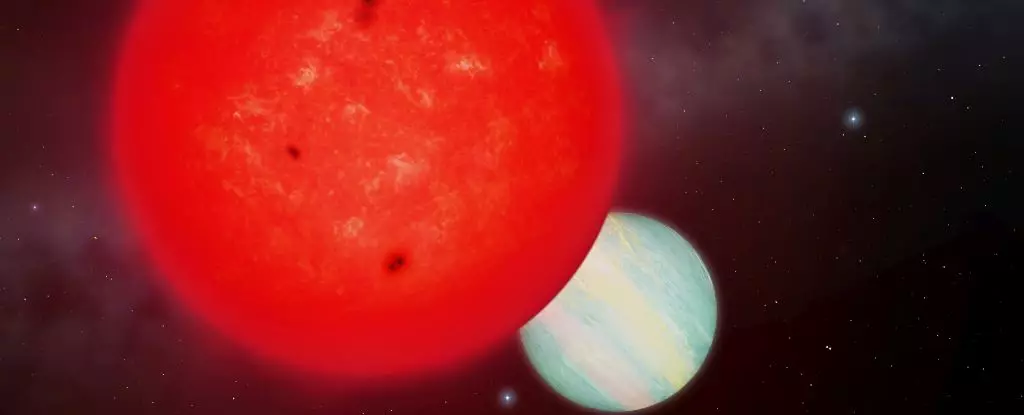In an astonishing twist of cosmic fate, astronomers have unearthed a substantial gas giant orbiting a diminutive red dwarf star known as TOI-6894, which is only a fraction of the size of our Sun. Labeling this revelation a “conundrum,” scientists initially doubted that such small stars could cradle planets of significant size, particularly gas giants like TOI-6894b, which boasts a radius approximately 86% that of Jupiter. The implications of this discovery challenge existing paradigms of celestial formation and expand our understanding of how planets can arise around stars that, by conventional wisdom, shouldn’t be able to birth such impressive worlds.
Astrophysicist Edward Bryant, who led the ambitious project at the University of Warwick, expressed his excitement, stating, “We did not expect planets like TOI-6894b to be able to form around stars this low-mass.” This statement perfectly encapsulates the thrill this discovery brings to the scientific community. What was once thought impossible is now a reality, serving as a cornerstone for future research into the tantalizing extremes of planet formation.
Understanding Planet Formation
To grasp the significance of TOI-6894b, one needs to delve into planetary formation mechanics. Generally, planets emerge from residual materials left after a star’s formation. As stars coalesce from dense clouds of gas and dust, surrounding material forms a disc—a nursery of sorts—feeding the burgeoning star. Traditional models suggest that the mass of a star determines the quantity of material available in this disc, which in turn affects the type of planets that can form. For tiny red dwarfs, like TOI-6894, the assumption has long been that their limited material would preclude the birth of massive gas giants. Yet, the existence of TOI-6894b throws this assumption into disarray.
This conundrum invites further investigation and perhaps even refinement of our current understanding of planet formation. Could there be unknown mechanisms at play, allowing planets to take shape even in seemingly inadequate conditions? As researchers examined TESS data for clues, the revelation of TOI-6894b indicated a broader prevalence of similar systems—suggesting a hidden reservoir of knowledge waiting to be explored.
Examining the Transit Method
The research team employed the transit method, a standard technique for discovering exoplanets, which has garnered fame due to its effectiveness in tracking orbital patterns. TOI-6894b’s discovery involved measuring the light from its host star as it dipped momentarily when the exoplanet crossed in front of it. The fact that this star’s light dipped by a staggering 17% during the transit illustrates the sheer size of the gas giant—a proportion that starkly contrasts with other exoplanets discovered around larger stars.
By assessing the gravitational effects exerted by the exoplanet on its star, researchers inferred that TOI-6894b has a mass around 17% that of Jupiter, implying that it potentially harbors a relatively fluffy atmosphere. This intriguing characteristic makes TOI-6894b especially appealing for atmospheric studies; the opportunity to analyze the starlight filtering through the planet’s atmosphere could lead to groundbreaking findings about its composition.
Future Insights into Atmospheric Chemistry
With follow-up studies already planned using sophisticated equipment like the James Webb Space Telescope, the potential to uncover the chemical makeup of TOI-6894b is nothing short of thrilling. Scientists particularly anticipate finding significant traces of methane, which could yield essential insights into the planet’s atmospheric dynamics and chemical processes. The outcomes of these studies hold the promise of reshaping our understanding of gas giants and their formation.
Andrés Jordán, an astrophysicist associated with the research, remarked on the exciting challenges this system presents for existing planet formation models. As we push the boundaries of our knowledge, understanding which formation mechanisms—whether gradual accumulation or direct collapse—were at work in TOI-6894b’s genesis may offer profound ramifications for our comprehension of planetary systems across the universe.
The Importance of Challenging Existing Paradigms
The discovery of TOI-6894b stands as a testament to the ever-evolving nature of scientific understanding. It serves as a reminder that the cosmos is filled with surprises and complexities that defy our established paradigms. As researchers continue to explore the universe’s depths, they are met with phenomena that challenge preconceived notions.
As astrophysicist Vincent Van Eylen aptly put it, “We don’t really understand how a star with so little mass can form such a massive planet!” This inquiry fuels the quest for knowledge, inviting us to expand our theories and methodologies. The hunt for further exoplanets is not merely a scientific endeavor; it is a call to embrace the multitude of possibilities that exist within our universe. The quest for understanding continues, and with discoveries like TOI-6894b, we are reminded that the next cosmic anomaly could just be around the corner.


Leave a Reply